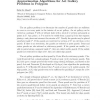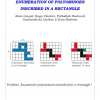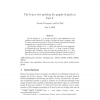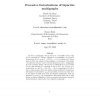DAM
2010
12 years 11 months ago
2010
DAM
2010
13 years 1 months ago
2010
An assignment of positive integer weights to the edges of a simple graph G is called irregular if the weighted degrees of the vertices are all different. The irregularity strength,...
DAM
2010
13 years 1 months ago
2010
DAM
2010
13 years 3 months ago
2010
We consider the problem of sorting a permutation using a network of data structures as introduced by Knuth and Tarjan. In general the model as considered previously was restricted...
DAM
2010
13 years 4 months ago
2010
A dynamic coloring of a graph is a proper coloring of its vertices such that every vertex of degree more than one has at least two neighbors with distinct colors. The least number...
DAM
2010
13 years 4 months ago
2010
DAM
2010
13 years 4 months ago
2010
An equivalence graph is a disjoint union of cliques, and the equivalence number eq(G) of a graph G is the minimum number of equivalence subgraphs needed to cover the edges of G. W...
DAM
2010
13 years 4 months ago
2010
DAM
2010
13 years 4 months ago
2010
For all integers k 3, we give an O(n4 ) time algorithm for the problem whose instance is a graph G of girth at least k together with k vertices and whose question is "Does G...
DAM
2010
13 years 4 months ago
2010
Let G be a multigraph. We say that G is 1-extendable if every edge of G is contained in a 1-factor. Suppose G is 1-extendable. An excessive factorization of G is a set F = {F1, F2...




